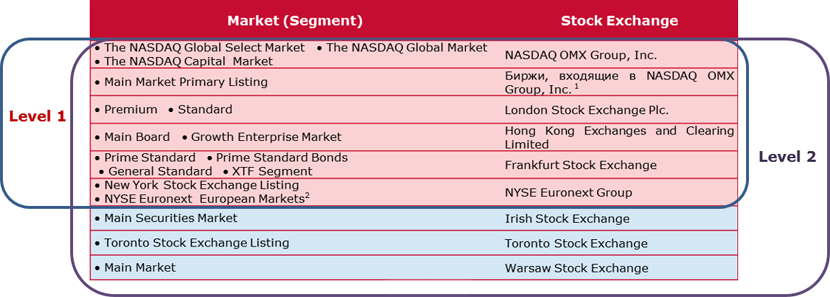Listing of Russian Depositary Receipts
In addition to direct access, foreign securities may be admitted to trading via issuing Russian Depository Receipts (RDRs).
Additional information on RDR issuance
Basic listing requirements
- Conformation of the securities with Russian legal requirements, including financial market regulations
- Issue prospectus registration procedure completed
- An issuer of RDR undertakes responsibility to disclose information on RDRs in accordance with Russian legal requirements
- The securities are accepted for servicing by the settlement depositary
With the basic requirements complied, securities may be included on Level 3.
Inclusion in Levels 1 and 2
Option 1
RDRs may be included on Levels 1 and 2 if the represented security meets the basic requirements and underwent listing on the relevant foreign exchange (Table 1). In this case there are no other requirements for listing on Levels 1 and 2.
Table 1

Option 2
In other cases, RDRs may be included in Level 1 or 2 if they meet the basic listing requirements and additional requirements depending on the type of underlying security.
Requirements for RDRs on shares to be listed on Level 1 and 2
Table 2
| Requirements | Level 1 | Level 2 |
|---|---|---|
| Number of shares in free float (FFs) and their free float market cap (FFC) |
Ordinary shares Market cap ≤ RUB 60 bln: Preferred shares |
Ordinary shares Prefs |
| Lifespan of issuer | At least 3 years | At least 1 year |
| Composition and disclosure of audited consolidated financial statements prepared in accordance with international standards |
For 3 years prior to the shares' inclusion on Level 1 |
For 1 complete year prior to the shares' inclusion on Level 2 |
| Corporate governance requirements | Requirements stated in p. 2.18 Listing rules | Requirements stated in p. 2.19 Listing rules |
Requirements for RDRs on bonds to be listed on Level 1 and 2
Table 3
| Requirement | Level 1 | Level 2 |
|---|---|---|
| Volume | At least RUB 2 bln | At least RUB 500 mln |
| Par value | No more than RUB 50,000 | |
| Lifespan of issuer or guarantor | At least 3 years | At least 1 year |
| Composition and disclosure of audited consolidated financial statements prepared in accordance with international standards |
For 3 complete years (issuer and guarantor) | For 1 complete year |
| Absence of losses | Positive GPnL for 2 of last 3 years | Positive GPnL for 1 of last 3 years |
| Absence of issuer default | Absent, or at least 3 years passed since default causing liabilities were ceased |
Absent, or at least 2 years passed since default causing liabilities were ceased |
| Presence of credit rating of issuer, issue, or guarantor | Rating specified in Table 4 | Conditions do not apply |
| Conformation to corporate governance requirements | Requirements stated in p. 2.20 of the Listing Rules | Conditions do not apply |
Inclusion on Level 1 is possible only when the issuer, issue, or guarantor has the requisite credit rating (Table 4).
Table 4
| Rating agency | International rating |
|---|---|
| Fitch Ratings CIS | B+ |
| Standard and Poor's International Services | B+ |
| Moody's Investors Service | B1 |
GPnL calculation
GPnL = PnLe + PnLg calculated for the required period, except cases stated in subpoints а) and b), described below, where:
- PnLe – issuer's financial result (profit or loss) according to an annual consolidated financial statement or, in case of absence, individual financial statement, for the last complete financial year;
- PnLg – guarantor's financial result (profit or loss) according to an annual consolidated financial statement or, in case of absence, individual financial statement, for the last complete financial year.
If an issuer or guarantor's financial statements show a loss, then PnLe and PnLg are negative, if they show a profit then PnLe and PnLg are positive.
а) if PnLe is positive, then GPnL equals PnLe;
б) If the issuer and guarantor are part of the same holding that composes consolidated financial statements in which the issuer and guarantor's assets, liabilities, capital, income, costs, and cashflow are presented as those of a single entity, then GPnL equals profit (loss) according to the annual consolidated financial statements.
When calculating GPnL, indicators of PnLe and PnLg are determined using the results of the legal entity (or one of the legal entities), the reorganisation of which resulted in the issuer and guarantor being founded.